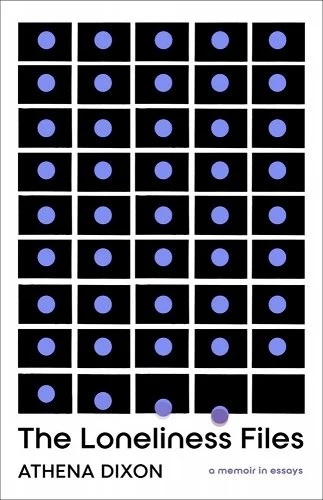[ad_1]
Athena Dixon is lonely. A middle-aged single woman without children or pets, she lives alone and works remotely, more than 350 miles from her family. In The Loneliness Files, a thought-provoking memoir in essays, she explores the many facets of her solitude and what they lead her to understand about herself and the world at her fingertips.
“What does it mean to be a body behind a screen, lost in the hustle of an online world?” asks the back-cover blurb. Despite our current hyperconnection, research shows that a significant amount of the population feels lonely. The lockdowns of the early pandemic compounded Dixon’s isolation, as they did for so many. This enforced alienation exacerbated her hunger for connection, fear of dying alone, and fierce desire for a legacy. But, as Dixon goes on to illustrate, loneliness has always been a constant in her life.
The Loneliness Files surprised and touched me. Although I am a married mother of three for whom the pandemic lockdowns represented an opposite challenge (never being alone takes a different kind of toll), I found kinship and recognition in Dixon’s writing, rather than simply a peek at a foreign lifestyle. Loneliness can spring from aloneness, sure, but alone and lonely are fundamentally different as Dixon quickly explains. “Alone seems like a choice,” she writes in her first pages. “Loneliness doesn’t.” In sixteen essays, Dixon shows how loneliness is born of distance, grief, worry, or trauma. Loneliness can also stem from estrangement from our former selves or homes, or a discomforting awareness of our mortality.
The Loneliness Files is broken into three parts: “Life as It Is,” “Out in the World,” and “Coming Home,” each accompanied by recommended song titles. These mostly mellow, ethereal tunes—“Strange” by Celeste, “Hypnosis” by Raveena Aurora, “Umi Says” by Mos Def—pull the reader into Dixon’s headspace, bridging a sort of sensory gap between author and reader. She achieves this as well by excerpting, in a central essay, some of the most stark and painful thoughts in a decade’s worth of diary entries, showing the persistence of loneliness in her life and lifting a sort of curtain to her vulnerability. The reader understands that Dixon is committed to deep honesty, a sort of raw nakedness on the page, and this doesn’t feel attention-seeking or sensational. Rather a rabid curiosity seems to fuel her, one that will only engender results if she exposes her deepest self without censure. “My loneliness is not groundbreaking,” she writes. “And it is not tragic. It just is. Nothing more and nothing less. I don’t expect it to be important to anyone other than myself, but I write about it anyway.”
Dixon’s ambivalence toward her loneliness is arguably the most compelling aspect of The Loneliness Files, the counterpoint to any possible claims of self-pity. While she feels starved for connection, she seems equally reluctant to let go of her solitude, because of the comfort it brings. “My loneliness is deep. It’s oddly comforting because I know what to expect.” Matter of fact, she writes: “I am overwhelmingly lonely.” But she also explains that her loneliness evolved from a coping mechanism—due presumably to a deep depression—to a purposeful lifestyle. “I choose now to connect and know keenly when I must untether.” Her drive to reconcile the divergence between comfort and longing propels the narrative.
In the opening essays of Part One, Dixon investigates the lonely deaths of several women, some who weren’t found for years after dying alone, another whose mysterious death became the focus of salacious online speculations. Dixon dives deep into internet research, trying to exhume these women’s humanity, to resurrect their dignity, but above all to pinpoint who she is in relation. “I’m obsessed with these lonely ends. I keep running into stories about them and I can’t let go because more often than not they are a reflection of me.” Discomfort remains about what her own legacy might become in a similar context. “What would the world say about me?” Dixon muses. This pressing existential concern is woven through her essays, this fear “that I will die alone. That no one will remember me.” At the root, The Loneliness Files offers a stirring meditation on mortality and the precise measure of a life.
The theme of ghosts recurs throughout the collection, both in terms of how loneliness threatens to erase Dixon and of what haunts her. “I exist—that is vastly true—but I feel like a ghost. Not fully fleshed but enough to draw attention when noticed.” Through social media, she stays in control of her carefully curated identity and online presence, a subtle connection to the world that brings her peace just as much as fear. She seems not to mind loneliness wholesale, but it’s the question of connection that haunts her—how to find it, how to sustain it. In the poignant essay “One Great Thing,” Dixon interrogates her value as a divorced middle-aged woman, neither wife nor mother, and mourns her unfulfilled desire for children. This piece braids together hometown lore about a haunted bridge from which mothers threw their unwanted babies and her own longing for a child. Her vivid, visceral need to have a baby slips away, not unlike the dreamlike memories of her own childhood. She searches for ghosts, longing for what was never there and nostalgic for what is no longer. “Children still haunt me,” she writes.
Pop culture is an important part of Dixon’s life and a topic that anchors the essays of Part Two in particular. The author is profoundly inquisitive, exploring and dissecting her eclectic interests. She analyzes the compelling duality of a horror film character, discusses the influence of rom-com films with her therapist, muses about her parasocial childhood crush on Star Trek’s Jake Sisko, and questions the merits of her popular Black Panther fanfiction. Screens serve as both the portal for Dixon’s understanding of the world and a mirror for her own self-exploration. The reader’s perception of her loneliness evolves to include her bittersweet detachment from former and alternate versions of herself, a familiar consideration for most.
“In Service of the Algorithm” is a notable essay, in which Dixon compares the film The Truman Show to our infinitely manipulated digital lives. She argues that while we may be increasingly aware of how the algorithm manufactures our reality, the bubble remains a comfortable place in which to dwell. “Somewhere between isolation and delusion, I continue to log on and be told who I should be or what is important.” Here again her ambivalence emerges, in the tug of her comfort zone even as it solidifies her solitude. Discouraged by online dating and the disappointing failure of previous relationships, she wonders about “the complexity of wanting someone to love when I don’t want to be bothered most days.” Yet she is drawn to the possibility of meaningful connection as if it were a treasure she has yet to discover: “I am afraid to die before I figure out what it is.”
Dixon is Black, and while the subject of race features in several essays, she explores its connection to loneliness more directly in Part Three, where she circles the theme of home. The lyrical and intense “You Have the Right to Remain Silent” brings the reader into her powerless panic as a teen pulled over by police for no clear reason. Other essays explore alcoholism in her lineage, the importance of superstition in forging rituals that link her to her family, and, when she returns to Ohio for her grandmother’s funeral, the ways she sees home through the filter of loss. “I am still reconciling what I am missing. I am still trying to piece together the love and grief of this place. Trying to see beyond a veil of tears or drinks or nostalgia and see what really is.” Here again the threads of belonging and ghosts coalesce.
The Loneliness Files ends with Dixon having come full circle, reminiscing alone on New Year’s Eve. While there is no tidy conclusion, there is the sense of an arduous journey reaching its end point, bringing with it both gifts and resignation. Ultimately what makes The Loneliness Files an engrossing, often astonishing read is the author’s admirable candor. By excavating her discomfort and divulging her most vulnerable longing, Dixon generates a higher, rarer level of connection with the reader—and that seems a powerful legacy.
The Loneliness Files is a deep and thoughtful collection, one I hope readers will savor and process and discuss. The best works of art lead us to consider our presence in the world and the ways in which we exist in relation to ourselves and others. While in the end Dixon may not solve the equation of her loneliness, she deepens her self-knowledge and, in so doing, offers us the tools to do the same.

NONFICTION
The Loneliness Files
By Athena Dixon
Tin House Books
Published October 3, 2023

[ad_2]
Source link

